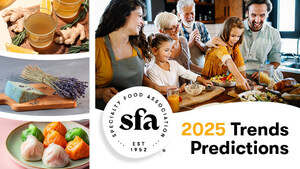Specialty Food Industry Sales Hit $127 Billion in 2016
NEW YORK, April 6, 2017 /PRNewswire/ -- Sales continue to grow as Americans embrace specialty food and beverages. The industry is taking its place as an integral player with traditional and non-traditional specialty food retailers, foodservice operators, and distributors.
The Specialty Food Association's (SFA) annual State of the Industry report, issued today, examines the vibrant $127 billion-dollar industry in detail. Largely fueled by small business growth, total sales jumped 15% between 2014 and 2016. Growth is also driven by product innovations and wider availability of specialty foods through mass-market outlets. Sales through foodservice increased 13.7% to $27.7 billion as U.S. consumers make specialty food a regular part of their away-from-home meal purchases.
"Consumer preferences for specialty food products are growing at double digits, outpacing mainstream food staples." said Phil Kafarakis, President of the Specialty Food Association. "The products our members create appeal to consumers looking for authentic tastes and foods with fewer and cleaner ingredients.
"Consumers are also making purchases wherever they happen to be, changing the retail food environment. The eagerness of all retailers including mass market, e-commerce, and foodservice to capitalize on these consumer trends is transforming the marketplace. Our research indicates that accelerated growth will continue and one of the things we'll be doing at SFA's 2017 Summer Fancy Food Show in June will be further exploring the projections we have for the future."
The full State of the Specialty Food Industry report, produced in conjunction with market researcher Mintel, is now available here.
Top trends identified in this year's SFA research include:
- Sales Growth - Online Accelerates, Traditional Slows – while growth at retail and foodservice have slowed – up only 5.5% versus 9.1% in 2015, growth in third party e-commerce and direct-to-consumer websites have gained ground, accounting for almost 36% of sales
- Retail Channels Heating Up – Millennials, one of the top growing consumer segments, buy specialty food wherever they shop. This trend has helped drive sales in multi-unit grocery and mass merchants, where growth outpaced that of natural or specialty chains for the first time
- Center Store Alive and Well – Grocery, shelf-stable specialty foods accounted for 61% of the total specialty food market in 2016 ($36.2 billion). Strong growth performance was seen in categories like wellness bars and gels, and nut and seed butters
- Shift to Sustainable – Close to 40 percent of manufacturers produced sustainable products, up 22% from last year. Among retailers, sustainable products accounted for 16% of product sales. Along with non-GMO, the supply chain predicts sustainable will be the claim most interesting to consumers in the next three years.
Consumers are especially focused on specialty foods in the refrigerated sections. Categories with the biggest sales growth in this area include refrigerated juices and functional beverages up 30.7%, refrigerated lunch and dinner entrees up 33.0%, and yogurt and kefir up 27.2%
An eight-page overview of the report is featured in the spring issue of Specialty Food Magazine. Those highlights, plus a larger summary report with charts data can be found here.
About the Specialty Food Association
The Specialty Food Association is a thriving community of food artisans, importers and entrepreneurs. Established in 1952 in New York, the not-for-profit trade association provides its 3,400 members in the U.S. and abroad with resources, knowledge and connections to champion and nurture their companies in an always-evolving marketplace. The Association owns and produces the Winter and Summer Fancy Food Shows, and presents the sofi™ Awards honoring excellence in specialty food. Learn more at specialtyfood.com.
SOURCE Specialty Food Association
Related Links
WANT YOUR COMPANY'S NEWS FEATURED ON PRNEWSWIRE.COM?
Newsrooms &
Influencers
Digital Media
Outlets
Journalists
Opted In






Share this article